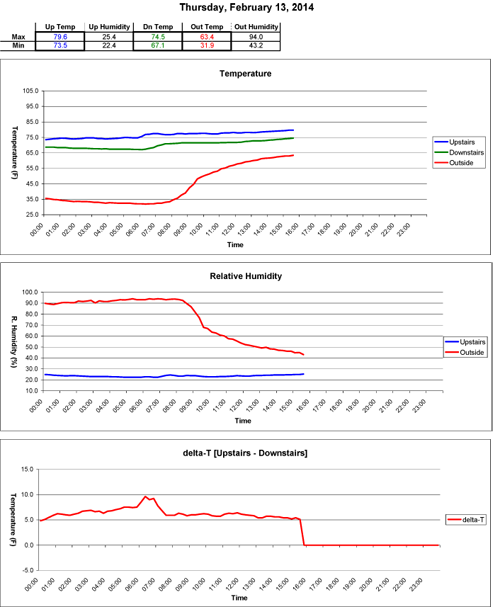A Temperature/Humidity Datalogger Using the P8X32A
The Thermo-Prop system consists of three modules, all utilizing a Parallax P8X32A (Propeller) microcontroller
for a ‘brain’. This project originally started as an upstairs/downstairs thermostat, but has morphed
into a data logger. I may eventually add a fourth module to interface to my home HVAC system. Currently
the system logs temperature & humidity from the outside and the upstairs of my house, and temperature only
from the downstairs of my house. Data is communicated wirelessly via XBee and logged to a microSD card every 15 minutes.
The master unit, Thermo-Master, is located upstairs and contains the microSD card which is used to store the
collected data. The Thermo-Master has a DS3231 Real Time Clock with battery backup (BR1225) and uses a Sensirion
SHT11 module to read the temperature and humidity. An XBee Wireless RF module is utilized to communicate
with the remote units. The user interface consists of a single pushbutton, to set the date and time, and a
4-line by 20-character LCD displaying collected information in the following format:

The outside unit, Thermo-Slave, is mounted to an outside wall of my house (with a Velcro strip).
A location was chosen that is shielded from direct sunlight. The module is powered by 3 AA batteries;
typical battery life is on the order of 90 days. A Sensirion SHT11 temperature/humidity sensor is used
to measure the outdoors conditions. An XBee Wireless RF module transmits the locally collected data
to the Thermo-Master unit. Since it is battery powered, this unit spends most of its time in low-power mode,
only ‘waking up’ every 10 minutes (roughly) to take a reading and transmit the data. Without the power-down,
the batteries will only last 7-8 days!
The downstairs unit, Thermo-Down, is, obviously, located downstairs. The downstairs unit does not measure
relative humidity, only temperature. A DS18B20 One-Wire Digital Thermometer is used for the temperature sensing.
An XBee Wireless RF module is employed for communication with the Thermo-Master unit. The user interface consists of
a single pushbutton, which requests the current date/time and outside temperature from the Thermo-Master unit, and a
2-line by 16-character LCD with the following information:
As mentioned, pressing the pushbutton will display the date/time and outside temperature for 5 seconds:
When reset, the Thermo-Master unit will display the current date and time, updated every second,
and the local temperature and humidity, updated every 5 seconds. The downstairs 'DN' and outside 'OUT'
data will be blank.
The outdoors unit is the key to the data exchange between the various modules. In the battery-powered Thermo-Slave
unit, the Propeller and XBee are put into a low-power mode, with the Propeller doing a slow count.
Approximately every 10 minutes, the Propeller powers-up, wakes up the XBee, gets a reading from the
SHT11, and transmits the temp/humidity to the Thermo-Master unit. The Propeller then puts the XBee back
to bed, and returns to low-power mode.
When the Thermo-Master receives the data from the outside unit, it stores it internally and
updates the data on the LCD. It then sends its own (upstairs) temperature to the Thermo-Down unit.
The Thermo-Down module will store this information and update the data on its own LCD.
It will then transmit its local (downstairs) temperature back to the Thermo-Master unit.
The Thermo-Master again stores the data and updates the LCD display.
Every fifteen minutes, on the quarter-hour, the currently stored information is written to a
text file on the microSD card; the values are comma-separated, stored in a .CSV file.
At midnight, a new file is created, with the filename in the format of yy-mm-dd.csv.
When the new file is created, a header line is also written. A small example of a log file:
Date,Time,Upstairs (F),Humidity (%),Downstairs (F),Outside (F),Humidity (%)
02/13/14,00:00, 73.5, 24.8, 68.7, 35.5, 89.8
02/13/14,00:15, 73.8, 24.6, 68.7, 35.3, 89.3
02/13/14,00:30, 74.1, 24.3, 68.6, 34.8, 88.8
02/13/14,00:45, 74.3, 24.0, 68.4, 34.6, 89.6
02/13/14,01:00, 74.5, 23.9, 68.3, 34.2, 90.5
02/13/14,01:15, 74.4, 23.7, 68.3, 34.1, 90.7
02/13/14,01:30, 74.1, 23.8, 68.1, 33.8, 90.4
02/13/14,01:45, 73.9, 23.9, 68.0, 33.5, 90.5
I copy the log files from the microSD card, usually once a week. Data is copied to an Excel
workbook (each workbook contains one month of data) with a tab for each day of the month
and a summary page at the front. Each day page is identical. A button is provided on the first
page to activate a macro to rename the day tabs ('Feb-12', 'Feb-13', etc.). The data file is
copied into the appropriate worksheet day. The worksheets are constructed to extract
minimum/maximum data, and produce line graphs of temperature and humidity related to time of day, as below:
Hardware & Software Details:
![[ Home ]](images/HomePage.png)
Last updated: 14 Feb 2014
Web Author: John Locke
Copyright © 2014 IdleTime Industries - ALL RIGHTS RESERVED




